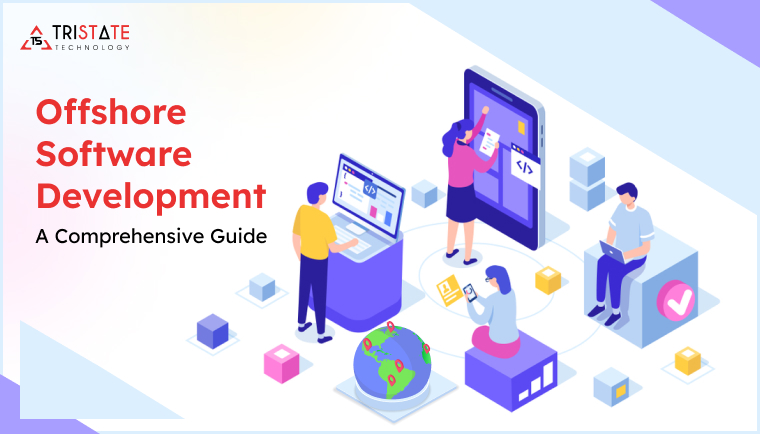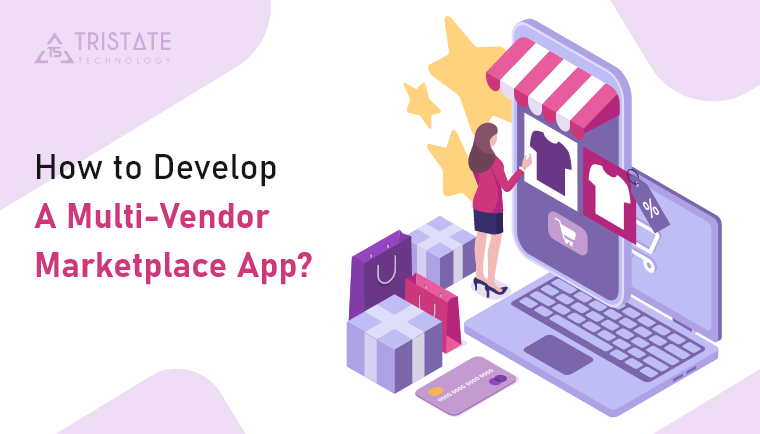
“Man, I wish I could own this shopping mall.”
How many times have you stepped into a shopping mall, and the thought of owning it has run through your mind?
But of course, starting a shopping mall isn’t a piece of cake. The construction costs are massive, let alone the management responsibilities that come with it.
But what if you could own an online shopping mall, with individual shops selling products to customers? With marketplace app development, this idea can certainly be turned into reality.
In this post, we’ll dive into how you can develop a multi-vendor marketplace app, along with its key features and monetization strategies.
What is a multi-vendor marketplace app?
A multi-vendor marketplace is a platform where multiple sellers sell their products.
Let’s return to the shopping mall example. A mall has different shops run by individual owners. As the mall owner, you aren’t responsible for running or managing the shops. Instead, your focus is more towards ensuring seamless storage and delivery of the product, along with hassle-free payment collection.
Now, if you transform a shopping mall into an online setup, you’ll get a multi-vendor marketplace. It’s an online platform where third-party vendors sell their products and services. And as the marketplace owner, you’re responsible for storage, shipping, and payments.
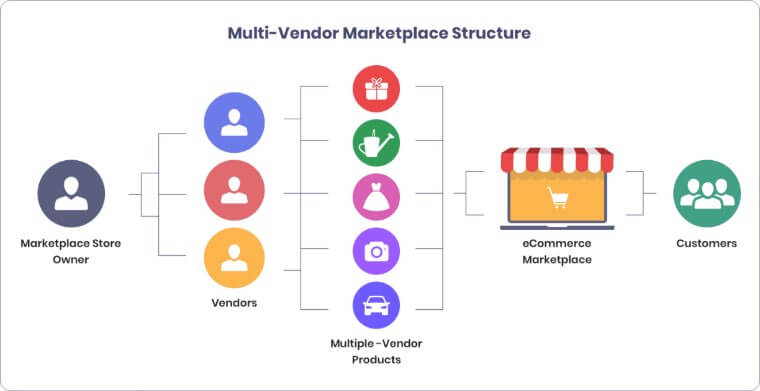
Source: Codica
Amazon and Alibaba are common examples of multi-vendor marketplace applications.
Types of multi-vendor marketplaces
Multi-vendor marketplaces are broadly categorized into two categories: horizontal and vertical. Horizontal marketplaces facilitate the buying and selling of a wide range of products across various niches, thereby catering to a wider audience. A vertical marketplace, on the other hand, sells niche-specific products. It caters to a narrower, more specific audience.
In addition, multi-vendor marketplaces can be classified into three types:
- B2B marketplace: A B2B marketplace is a platform where vendors sell products to other businesses at a wholesale price. Some examples include Alibaba and Walmart.
- B2C marketplace: A B2C marketplace is a platform where vendors sell products to customers. Amazon, Etsy, and Flipkart are common examples.
- C2C marketplace: A C2C marketplace is a platform where customers sell products to other customers. eBay is a popular example of a C2C marketplace.
The type of multi-vendor marketplace you’ll develop will depend on your business strategy. If you want a B2B platform, Alibaba-like platform development will be ideal. If you want a B2C marketplace, Amazon-like app development will be the ideal pick.
Multi-vendor marketplace market: an overview
There’s been no better time than 2020 for Marketplace app development. According to Grand View Research, the global eCommerce market was valued at $9.09 trillion in 2019 and is projected to grow at 14.7% CAGR during 2020-2027.
When segmented, B2C and B2B multi-vendor marketplaces make the majority of the eCommerce market. The B2C eCommerce market was valued at $3.35 trillion in 2019, whereas the B2B eCommerce market crossed the $5 trillion mark.
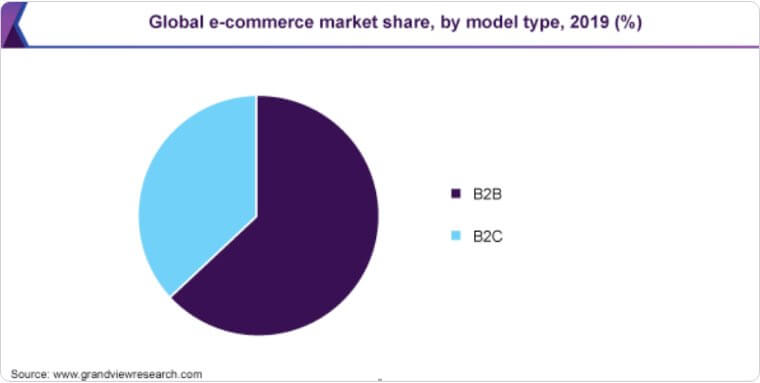
Source: Grand View Research
The C2C multi-vendor market has also witnessed steady growth, but the future of the market remains uncertain. The United States remains the leading consumer of C2C services, with eBay being the biggest C2C marketplace.
Business benefits: why develop a multi-vendor marketplace app?
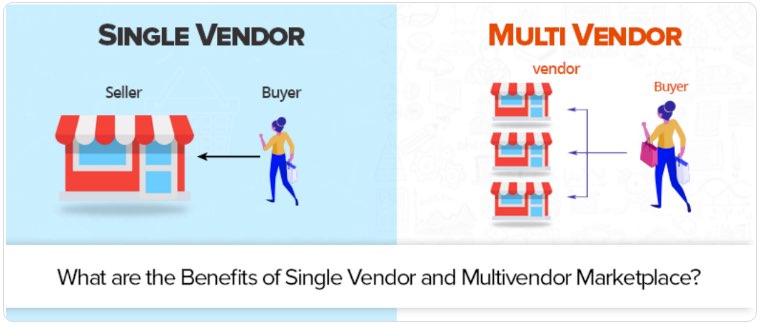
Source: Webnexs
Multi-vendor marketplaces like Amazon and Alibaba are thriving. Small business owners need a place to sell, but they don’t have the resources to set up a full-fledged eCommerce store, attract customers, and manage sales and shipping. Hence, they seek multi-vendor marketplaces.
If you’re on the fence, not being able to decide whether to invest in multi-vendor Ecommerce app development, consider some of its key benefits.
1. More products means more customers
As a multi-vendor marketplace owner, you have the luxury to add more sellers, and thus, more products. This gives customers the flexibility of choosing and purchasing different types of products from one place.
Hence, you’ll offer a diversified shopping experience and attract more customers compared to a solo marketplace. Simultaneously, vendors will prefer a multi-vendor marketplace because they get access to a vast group of customers without putting in any marketing efforts.
2. Seamless inventory management
In a multi-vendor marketplace, you don’t have to maintain the entire warehouse of products. All the vendors are responsible for maintaining their inventories. This releases significant financial and management burden, allowing you to focus on core tasks.
3. Reduced operational costs
Let’s delve into how a typical online business works. First, you come up with a product, which is the most tormenting task. You’ll need to come up with a winning product idea that customers would love. And one product won’t cut it. You’ll need to sell multiple products to keep the customers interested.
Once you have the product range ready, you’ll need to set up an eCommerce store and attract customers. You’ll also need to manage inventory, shipping, returns, product support, and the list goes on.
But with Amazon-like app development, you can dodge most of these. All you need to do is develop the marketplace, fulfill the orders, and accept the payments. The rest of the back-end operations like support and inventory management are up to the individual vendors.
As a result, you can reduce operational costs to a large extent.
4. Easy profits
Well, there’s nothing like easy profits. You’ll still need to attract customers and facilitate sales. But it’s easier compared with a solo marketplace. Since you have multiple vendors under one roof, getting more customers is effortless.
Moreover, a multi-vendor marketplace has several monetization options. The most common is to charge a percentage from the vendors on each sale, and you’re free to decide the percentage amount. Additionally, you can offer subscription plans, like Amazon Prime, to further up your revenue.
Key features of a multi-Vendor marketplace app
A multi-vendor marketplace app has three panels: Customer panel, Vendor Panel, and Admin Panel. Let’s look at the salient features of each panel.
1. Customer panel
- Sign up and login
- Search results, filtering, and sorting
- Vendor listing and detail
- Product lists and details
- Multiple payment methods
- Notifications and alerts
- Ratings and reviews
2. Vendor panel
- Sign up and login
- Profile edit and update
- Product listing
- Receive and accept orders
- Accept payments via multiple payment methods
- Complaint booking requests
- Alerts and notifications
3. Admin panel features
- Vendor management
- Customer management
- Category and sub category management
- Ratings and review management
- Complaints management
- Reports management
- Earnings management
How to monetize your multi-vendor marketplace app?
Let’s talk about business. What’s your final objective with Marketplace app development? Isn’t it to sell more and earn more?
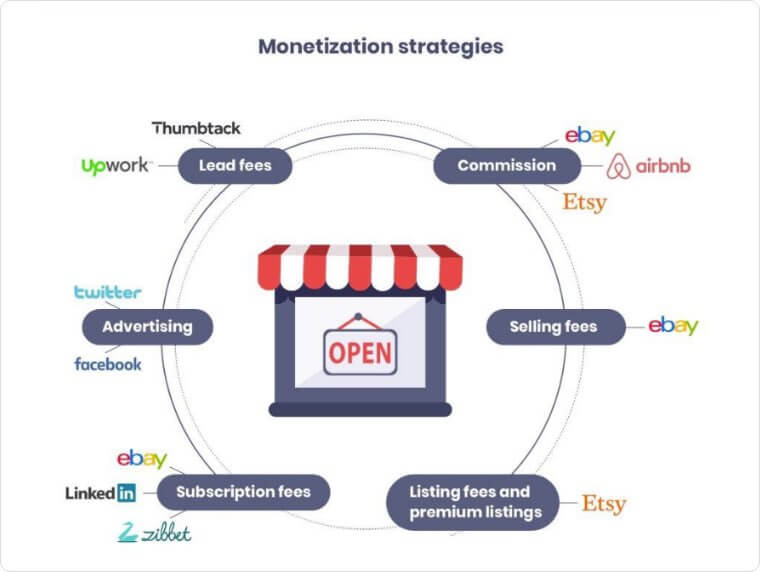
Source: Codica
But selling isn’t the only way to monetize your marketplace. Let’s look at the most common revenue generation models for a multi-vendor marketplace.
1. Sales commission
The most common way to monetize your marketplace is by earning commissions from vendors on each sale. You can decide upon a percentage (usually 5-15%) per successful sale. Most online marketplaces like Amazon and Etsy, rely on this model for generating revenue.
2. Membership model
Providing subscription-based services is another common way to monetize your marketplace. If you’re looking forward to strong>Amazon-like app development, you can use this model.
In the membership model, you sell subscriptions to your customers, and in return, you provide them with extra benefits. These benefits could be same-day delivery, zero delivery charge, etc.
3. Advertising model
Putting ads on the website is one of the oldest ways to generate revenue. And it still works. You can join an ad network like Google Ads and allow it to display ads on your site. You can select the advertising model – cost per mile (CPM) or cost per click (CPC) – to generate revenue on your online marketplace.
4. Sponsored sites
You can also partner with other websites and marketplaces. New businesses and websites are always searching for advertising space where they can get a good amount of eyeballs and recognition. You can offer them ad space on your site and charge for the sponsorship.
Multi-vendor app development process
We’ve discussed why you should opt for Amazon or Alibaba-like platform development, its scope, and the monetization possibilities.
Now, let’s take a look at the step-by-step multi-vendor eCommerce app development process.
- Find your niche.
- Develop the multi-vendor marketplace app.
- Find and partner with vendors.
- Attract buyers and make sales.
- Constantly improve your multi-vendor marketplace platform.
Technology stack
Here’s the technology stack required for marketplace app development.
- Programming Languages: Java, Node.js , Python, PHP
- Front-End: ReactJS, Angular, HTML5, Custom CSS, Bootstrap CSS
- Back-End: JavaScript
- Mobile: Java (Android), Swift (iOS), React Native (cross-platform)
- Infrastructure: Amazon Web Services (AWS)
- Databases: MySQL, MongoDB, PostgreSQL
- Payments: Stripe, PayPal, Braintree
- Analytics: Google Analytics
- Marketing Automation: MailChimp, HubSpot, Marketo, Eloqua
Bonus tip: Utilizing this comprehensive technology stack to develop a cutting-edge, fully-functional multi-vendor marketplace can be time and resource-intensive. At TriState Technology, we develop best-in-class multi-vendor marketplace applications for you at affordable costs.
Wrapping up
Vendors need a platform to sell to more customers, and customers need a place to browse between different vendors and products. A multi-vendor marketplace app creates a buyer-seller ecosystem, offering benefits to both parties.
Thus, multi-vendor marketplaces are in great demand, and they make for a lucrative business idea.
If you’re planning multi-vendor eCommerce app development, check out TriState Technology for expert on-demand app development solutions.


